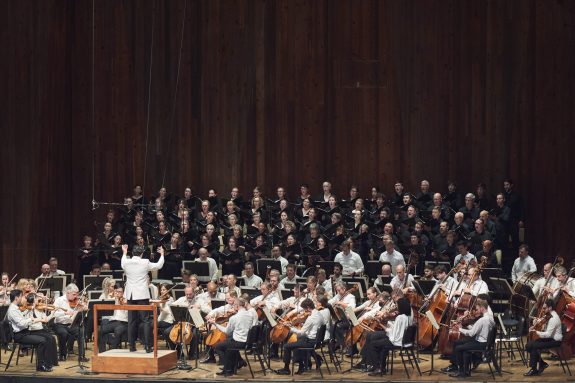 United States Blossom Festival 2024 [2] – Borodin, Arutiunian, Rachmaninoff: Michael Sachs (trumpet), Cleveland Orchestra Chorus (chorus director: Lisa Wong), Cleveland Orchestra / Domingo Hindoyan (conductor). Blossom Music Center, Cuyahoga Falls, Ohio, 13.7.2024. (MSJ)
United States Blossom Festival 2024 [2] – Borodin, Arutiunian, Rachmaninoff: Michael Sachs (trumpet), Cleveland Orchestra Chorus (chorus director: Lisa Wong), Cleveland Orchestra / Domingo Hindoyan (conductor). Blossom Music Center, Cuyahoga Falls, Ohio, 13.7.2024. (MSJ)

Borodin – Polovtsian Dances from Prince Igor
Alexander Arutiunian – Trumpet Concerto in A-flat major
Rachmaninoff – Symphony No.3 in A minor, Op.44
Domingo Hindoyan made his Cleveland Orchestra debut at the Blossom Music Festival in an all-Russian program. It started with the return of a once commonly-heard showpiece, Borodin’s Polovtsian Dances. In the mid-twentieth century, some fools started the Balkanization of classical music by sloughing off crowd-pleasers like this one to ‘pops’ concerts. The decline of popularity and relevance of classical music began about the same time (surprise, surprise). May such pieces continue to be brought back into the fold of regular orchestra concerts because that’s where masterpieces belong, even if they are colorful instead of profound. Dine on a diet of philosophy and trauma every day, and you will go as mad as Nietzsche. Fun music matters.
Alexander Borodin was a full-time chemistry professor and part-time composer. He approached composition like a chemist, always experimenting to see how different musical tones interacted, and how the introduction of a harmonic change could send a piece off in a new direction. The Polovtsian Dances are from his unfinished opera Prince Igor, and they were a typical operatic excuse for lavish singing and dancing. But more than most set pieces, these dances are masterpieces of musical chemistry. After the whirling introductory dance, Borodin spins out a mellifluous melody and paired countermelody of almost unbelievable length, followed by wildly addictive fast tunes with generous percussive support.

This performance of the dances happily included the Blossom Festival Chorus, the summer iteration of the Cleveland Orchestra Chorus, directed as always with alacrity by Lisa Wong. The vocal contribution enriches the already sumptuous dances, and they were a delight to encounter here. Daniel McKelway started things off with the skirling clarinet solo, which he accomplished with verve even at Hindoyan’s brisk tempo. The tempo was at the edge of manageability, though more troublesome was the conductor’s disregard for the Blossom pavilion’s acoustics which tend toward the resonant. A slightly less harried tempo would have let the music open up a little more.
Hindoyan set down his baton to direct the following lyrical dance with his bare hands, softening the orchestral response and helping to shape the ebb and flow of the gorgeous melody. He picked the baton back for the following fast dances, directed with efficiency and without a lot of extraneous gestures. He set the baton back down for the à tempo recap of the lyrical theme, which was perhaps not a good idea: the rhythmical underpinning from the previous dance continues, or should continue, crisply. Hindoyan slightly relaxed the tempo, and his flowing hands did not help the rhythmic lines stay focused. Everyone pulled it back together and continued on. The conductor resumed use of the baton and pushed the dances to an exciting conclusion.
The guest soloist for the evening was the orchestra’s own principal trumpet, Michael Sachs. Still in remarkable form in his thirty-sixth season with the orchestra, he brought a popular brass showpiece for its Cleveland Orchestra premiere, Alexander Arutiunian’s Trumpet Concerto. Without the advocacy of trumpeters, who have only a small repertory of solo pieces, this concerto would very possibly sink into the obscurity of most of Arutiunian’s other works. He was one of the mostly faceless Soviet composers who toed the line of writing the kind of folk-influenced, non-threatening, non-political, non-experimental music that Joseph Stalin wanted. But in this concerto, he paired a colorful approach with a fanfare-like principal theme that easily sticks in the memory. Contrasting the virtuoso fireworks with some excellent lyrical passages made the piece a hit.
Sachs is the orchestra’s golden lion and hearing him in the Arutiunian concerto was a delight. He can easily top the entire ensemble with his rich, burnished tone, or fire out fast notes with blistering accuracy, but he showed a classy restraint. In one delightful passage, Sachs demonstrated his regard for his colleagues, controlling his volume to let the strings sing and bringing up his own level at the end of phrases: his sound emerged, then settled back into the string wash, then emerged again. Hindoyan kept in step throughout, letting Sachs take the lead and shine at key moments.
Hindoyan, who is chief conductor of the Royal Liverpool Philharmonic in England, savored the challenges of Rachmaninoff’s Third Symphony, arguably the toughest nut to crack of this composer’s orchestral pieces. Rachmaninoff’s most effective pieces go dark, such as his First Symphony, the Symphonic Dances, or the Paganini Rhapsody, heard in the first Summers at Severance concert just two days previously. In the Third, the exiled Russian composer attempted to pick up the shattered pieces of his previous life and reassemble them, but after twenty years of rootless life in western Europe and the USA, he discovered the pieces no longer fit together. The piece is fitful and episodic as Rachmaninoff tries to force nostalgia and shaky optimism together, skirting the darkness that keeps lapping at its edges.
I heard André Previn conduct the piece with the Pittsburgh Symphony twenty-five years ago, and it speaks well for Hindoyan that his grasp of the work is comparable. Principal clarinet Afendi Yusuf took the numerous poignant solos, with principal horn Nathanial Silberschlag nailing his noble solos. The orchestra illuminated the piece with warmth, embodying the story of Rachmaninoff’s life as reflected in his music.
Mark Sebastian Jordan
